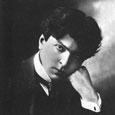George Enescu (1881-1955) was a Romanian composer, violinist, conductor, and teacher. He is commonly regarded as his country’s most famous and greatest musician, and many comparisons to Mozart’s precocious musical gifts abound. He began to play violin at age 4 and composed a year later. By 14 he was a student at the Paris Conservatory. He is so revered in Romania today, that the town of his birth, a museum, and the symphony orchestra in Bucharest have been named after him.
Outside of Romania, he is known by Georges Enesco, the form of the name that he adopted while living in France. His most famous violin student was the great Yehudi Menuhin, who remembers with great fondness his teacher’s ability to play both the Bach Urtext editions and the complete Wagner Tristan and Isolde from memory at the piano. “I recall the day he sat at an upright piano and hammering, crooning, whistling the various parts, evoked Tristan and Isolde more dramatically than an operatic company.”
Enescu made his conducting debut in 1923 with the Philadelphia Orchestra, performing in New York City. Later he would conduct the New York Philharmonic and the Orchestre Symphonique de Paris.
Enescu considered himself first and foremost, a composer, and his two most famous works, the First and Second Rumanian Rhapsodies, are his most well known orchestral works. He grew to hate these youthful compositional efforts, as he considered many of his later works more important, but they are colorful showpieces that are well received by audiences and musicians alike.
The First Rhapsody was composed in 1901 and scored for three flutes, the third doubling piccolo. The work is a medley of folk-inspired melodies that constantly increase in tempo along the way, including a waltz and many quick duple-meter gypsy inspired dance tunes.
Many of the important piccolo lines are not solos, but solo passages in which the piccolo player is at the top of the tutti woodwind choir. Make sure that you are on the forward edge of the tempo in these lightning fast technical passages. Use a tone color that is bright and flexible: do not overblow in an attempt to lead these lines. Keeping the tongue high in the mouth creates an E vowel sound that results in a sparkling tone color – very appropriate for passages such as this.
There is an accelerando through the measured trill, so make sure that you have great eye contact with the conductor as the tempo changes. By the time you reach the faster tempo, the quarter note will be about 160-168.
.jpg)
The melodic phrase at 20 is another spot for careful, light ensemble playing. Make sure that the articulation is crisp on the dotted eighth/sixteenth passages. Even though this passage is written in duple meter, it helps to think of it in one beat to the bar, so that you achieve the proper propulsion.
.jpg)
Keep the pitch high enough. I suggest the fingering 23 2 4 for this particular voicing to match the first violins. This
long, exposed C# occurs two times in the work, once at rehearsal 25 and again at rehearsal 29.
.jpg)
The passages through 27 are a lot of fun to play. If you have practiced your minor scales well, you will have no technical trouble.
.jpg)
Orchestral showpieces are fun to play and give piccolo players a chance to work on virtuosic technical tutti playing. I have never seen this particular piece in any excerpt book, yet it’s technical challenges are worthy of inclusion. Enjoy your chance to shine in the ensemble setting.
Editor’s Note: Romania or Rumania? Rumania, and Roumania are used as alternates with Romania, but Romania is preferred. The Romanian Embassy in Washington D.C. states, “(Romania in English, Roumanie in French, Rumänien in German). This name was adopted in 1862, after the nation-state had been founded through the union of the two Romanian principalities of Wallachia and Moldavia in 1859.”
The designation on the top of the orchestral parts reads Rumanian Rhapsody No. 1, and Wikipedia states, “The name România as common homeland of all Romanians is documented in the early 19th century…. This name has been officially in use since December 11, 1861.
“English-language sources still used the terms Rumania or Roumania, borrowed from the French spelling Roumanie, as recently as World War II, but since then, those terms have largely been replaced with the official spelling Romania."






